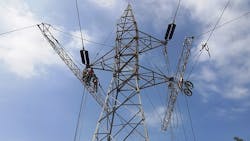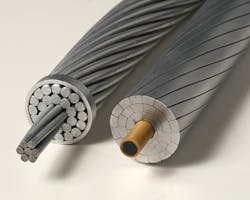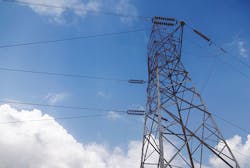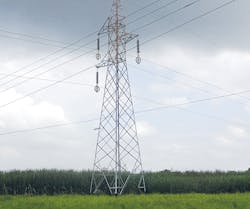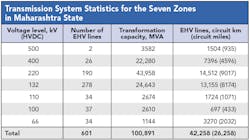India has experienced consistent economic growth over the past decade, and Nashik City was recently ranked 16th of India’s fastest-developing cities. Nashik City is located in the northwestern region of Maharashtra, 170 km (106 miles) from Mumbai. The Maharashtra State Electricity Transmission Co. Ltd. (MSETCL) is responsible for the transmission system and infrastructure required to supply the entire Maharashtra state.
The MSETCL transmission system for Nashik City includes a 17.2-km (10.7-mile) section of 132-kV single-circuit overhead line between Eklahare and Ozar. Erected in the late 1960s, this section of the line crosses two major highways, a railroad track and a river with a crossing span of 400 m (1312 ft).
The load-transfer capacity of this section was deemed to be inadequate, imposing a constraint on the transmission system that could ultimately result in load shedding at times of peak load. MSETCL also was aware of increasing demands on the transmission system to supply new industrial applications. For a variety of reasons, including the need to comply with the mandate issued by the Indian Ministry of Power to provide a reliable 24/7 supply of electrical energy, MSETCL was obliged to upgrade this section of the transmission system.
Reinforcement Alternatives
MSETCL launched a comprehensive study to review the following four reinforcement options:
•The first option was to erect an additional circuit on existing towers. Unfortunately, the existing lattice structures were not designed to accommodate an additional circuit.
• The second option was to construct a new parallel transmission line. However, rapid urbanization, escalating land costs and right-of-way challenges made this option prohibitively expensive. Furthermore, a right-of-way can take several years to negotiate in addition to the time needed to construct a new 132-kV circuit.
•The third option was to replace the existing 158.1-sq mm (310-kcmil) Wolf aluminum conductor steel-reinforced (ACSR) conductors with higher-capacity conventional conductors. This would require lattice tower replacement because of the additional structural loading and relative condition of the existing structures. Thermal sag associated with the conventional conductors also was a concern. Additionally, the existing conductors at the end of the transmission line in close proximity to the 400-MW Eklahare generating station were in poor condition due to pollution.
•The fourth option was to replace the existing ACSR conductors with commercially available high-temperature, low-sag (HTLS) conductors without having to replace or reinforce the existing tower structures.
After considering the options, MSETCL decided to examine the technical characteristics of several HTLS conductors.
ACCC Solution
MSETCL conducted a techno-commercial assessment of available alternative conductors, taking into consideration conductor sag, ampacity, line losses, anticipated longevity and cost. The results favored the aluminum conductor composite core (ACCC) conductor. Initially, MSETCL was apprehensive about the bending flexibility of the composite core, a main feature of the ACCC conductor. Following product demonstrations and on-site handling of this conductor, the utility had sufficient confidence to select the ACCC conductor for this project.
The fact that more than 25,000 km (15,535 miles) of ACCC conductor had been installed previously on more than 300 projects in 30 countries also inspired much confidence. In addition, the utility was pleased with the technical support provided by the manufacturers. Other characteristics that influenced MSETCL’s decision was the ACCC conductor’s ampacity is twice that of the existing ACSR conductor, and it offers lower line losses compared with other conductors operating under high load conditions. The apparent ease of installation and the fact it was manufactured locally under license from CTC Global by Sterlite Technologies also were attractive.
MSETCL selected the 273.6-sq mm (540-kcmil) Casablanca ACCC conductor to increase the load-transfer capacity of the circuit without having to upgrade the existing transmission line towers. The Casablanca ACCC conductor has a current-carrying capacity of more than 1100 A — more than twice the capacity of the existing Wolf ACSR conductor — which enables it to withstand increased loads and emergency conditions.
Another less obvious advantage of the ACCC conductor’s reduced line losses is the fact the energy normally lost in transmission can become available for other use. While it is common knowledge transmission and distribution line losses are high in India because of technical and commercial challenges, improvements in grid efficiency can have substantial overall benefits.
Construction Contract
The contract for construction of the transmission line was awarded to the Indian construction company M/S Rahul Agencies. MSETCL’s Nashik zone operation and maintenance group was the owner of the project overseeing complete construction. CTC Global and Sterlite provided basic training for the crews, as this was M/S Rahul’s first ACCC installation, so the project took longer to complete than originally anticipated.
MSETCL commissioned the reconductored 132-kV single-circuit transmission line in March 2014, and the circuit has been operating since then without any issues. Following MSETCL’s decision to use ACCC conductors, several other utilities in India have expressed their interest in using this type of conductor.
HTLS Benefits
In addition to the issues linked to seeking an additional right-of-way, the cost of constructing a new transmission line far exceeds the cost of upgrading existing circuits. Hence, MSETCL’s decision to reconductor its existing line resulted in significant savings in capital expenditure. Higher capacity also equates to greater profitability and lower line losses, therefore improving life-cycle costs compared with the other alternatives considered. Conventional line construction projects also often overrun, increasing costs.
Instead of constructing a new transmission line, the replacement of existing conductors with high-ampacity HTLS conductor helped MSETCL to increase the power transmission capacity in a much shorter time. The I²R losses of the HTLS conductor is 20% to 25% less compared with the conventional conductor.
The major generation facilities in Maharashtra are on the eastern side of the state, near coal mines some 700 km to 800 km (435 miles to 497 miles) from the western sector of the state that has seen rapid industrialization in the past few decades. Therefore, MSETCL was faced with a continuing challenge to upgrade the existing east-to-west transmission system. As a result of the overall benefits realized from the utility’s first project using ACCC conductors, MSETCL found an economic solution that could be expanded into using HTLS conductors to minimize future investment in its east-to-west transmission system.
Shrikrishna S. Navlakhe joined Maharashtra State Electricity Transmission Co. Ltd. (formerly MSEB) as a junior engineer in 1994. He is currently executive engineer (administration) in the extra-high-voltage construction operation and maintenance zone at MSETCL Nashik. Navlakhe is responsible for the MSETCL zone, which comprises 6826 circuit km of 132-kV to 400-kV lines with a capacity of 18,000 MVA.
